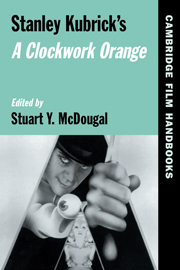Book contents
- Frontmatter
- Contents
- Acknowledgments
- List of Contributors
- Introduction: “What's it going to be then, eh?”: Questioning Kubrick's Clockwork
- 1 A Clockwork Orange … Ticking
- 2 The Cultural Productions of A Clockwork Orange
- 3 An Erotics of Violence: Masculinity and (Homo)Sexuality in Stanley Kubrick's A Clockwork Orange
- 4 Stanley Kubrick and the Art Cinema
- 5 “A Bird of Like Rarest Spun Heavenmetal”: Music in A Clockwork Orange
- REVIEWS OF A CLOCKWORK ORANGE, 1972
- A Glossary of Nadsat
- Filmography
- Select Bibliography
- Index
- References
4 - Stanley Kubrick and the Art Cinema
Published online by Cambridge University Press: 29 January 2010
- Frontmatter
- Contents
- Acknowledgments
- List of Contributors
- Introduction: “What's it going to be then, eh?”: Questioning Kubrick's Clockwork
- 1 A Clockwork Orange … Ticking
- 2 The Cultural Productions of A Clockwork Orange
- 3 An Erotics of Violence: Masculinity and (Homo)Sexuality in Stanley Kubrick's A Clockwork Orange
- 4 Stanley Kubrick and the Art Cinema
- 5 “A Bird of Like Rarest Spun Heavenmetal”: Music in A Clockwork Orange
- REVIEWS OF A CLOCKWORK ORANGE, 1972
- A Glossary of Nadsat
- Filmography
- Select Bibliography
- Index
- References
Summary
With A Clockwork Orange Stanley Kubrick signaled a new direction for art cinema even as he solidified his position among contemporary auteurs. Although Kubrick has never claimed that he was shifting paradigms for the art film, A Clockwork Orange raises crucial questions about how this twist in tradition ought to be understood. By basing his film on the Joycean text of Anthony Burgess's novel, and by emphasizing the book's more nihilistic elements, Kubrick made a film that shared the vision of the “art literature” of high modernism but had little in common with the art cinema of previous decades. The most admired films of Bergman, Kurosawa, Fellini, Truffaut, and the rest took large helpings of inspiration from the Realist novel of the nineteenth century or, as David Bordwell has more specifically suggested, from the works of Chekhov (p. 207). But A Clockwork Orange seems to draw upon writers such as Vladimir Nabokov, Bertolt Brecht, and Peter Weiss, as well as Samuel Beckett, who had won the Nobel Prize in 1969 when Kubrick's film was beginning to take shape in the director's mind. As in Waiting for Godot, there is nothing to be done in the dystopian future of A Clockwork Orange, in spite of the elaborate experiments in social engineering. In an additional departure from the traditions of the art cinema, the bleak, tragicomic vision of A Clockwork Orange was dressed up with styles of acting and cinematic violence that were anything but Chekhovian.
- Type
- Chapter
- Information
- Stanley Kubrick's A Clockwork Orange , pp. 85 - 108Publisher: Cambridge University PressPrint publication year: 2003
References
- 1
- Cited by



